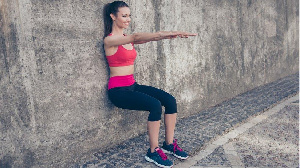BBC Pidgin of Saturday, 29 July 2023
Source: BBC
Di best exercises to lower high blood pressure
Exercise wey pipo wey get high blood pressure fit do to make am low na strength-training exercises like wall squats or holding di plank position.
These exercises dey among di best ways to lower blood pressure, one study suggest.
UK researchers call for update on di current guidance wey focus mostly on walking, running and cycling.
One analysis wey dem publish for di British Journal of Sports Medicine involve di trial of 16,000 pipo wey dey do different kain exercises to lower high blood pressure.
But di ones wey make sense pass na wall squats and planking, as e beta pass aerobic exercise.
Dem design these isometric exercises to build strength, wey pesin no go need move im muscles or joints.
Di plank position, resemble press-up, dem go put di elbow directly under di shoulders, stretch out di legs for back, dis go strengthen di abdomen.
Isometric exercises dey place very different stress on di body for aerobic exercise, study author Dr Jamie O'Driscoll, from Canterbury Christ Church University tok.
"Dem dey increase di tension for di muscles wen you hold am for two minutes, e dey cause sudden rush of blood wen you relax," e tok.
"Dis go increase di blood flow, but you must remember to breathe."
Wall squats involve positioning di feet 2ft (60cm) from a wall and sliding di back down until di thighs dey parallel to di ground.
Wetin be high blood pressure
High blood pressure dey put strain on di blood vessels, heart and oda organs, and dis dey increase di risk of conditions as pesin wey get am fit get heart attacks and strokes.
Treatment for high blood pressure dey mostly involve medication but patients also dey advised to eat healthy food, reduce di amount of alcohol dem dey take, stop smoking and exercise regularly.
Experts don advise pipo wey don pass 40-years-old to dey check dia blood pressure every five years.
Blood pressure dey recorded wit two numbers. Di systolic pressure (higher number) na di force wey di heart take dey pump blood around do body.
Di diastolic pressure (lower number) na di resistance to di blood flow for di blood vessels between heartbeats wen blood dey pump around your body.
Di pressure of blood for di arteries dey measured in millimetres of mercury (mmHg).
Below 130/85mmHg dey healthy while more dey 140/90 mmHg dey high, according to di study.
Risk of high blood pressure
If your blood pressure dey too high, e go put extra strain on your blood vessels, heart and oda organs, like di brain, kidneys and eyes.
Constant high blood pressure fit increase pesin risk of catching serious and potentially life-threatening health conditions like:
If you get high blood pressure, to try reduce am even wit small amount fit help lower your risk of these health conditions.
How exercise help lower high blood pressure
For dia analysis, researchers from Canterbury Christ Church University and Leicester University bin look at data from 15,827 pipo wey exercise for two weeks or more for 270 clinical trials wey dem publish between 1990 and 2023.
Dem discover say resting blood pressure dey reduced by:
These na small drops, Dr O'Driscoll tok, but dem fit lower pesin risk of stroke.
Current UK guidelines advise say make adults do at least 150 minutes of moderate-intensity exercise a week, or 75 minutes of vigorous activity, plus muscle-strengthening exercise two times a week.
In addition, Dr O'Driscoll tok say make dem consider two minutes of wall squats, or holding di plank position four times wit two minutes' rest in between, three times a week.
Read full article
Entertainment













